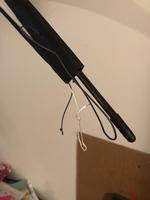-
Posts
3,680 -
Joined
-
Last visited
-
Days Won
57
Content Type
Profiles
Forums
Gallery
Downloads
KL Shop
Blogs
Articles
Posts posted by Wayne Dowler
-
-
Best check any altitude restrictions at places you go!
-
Take the time to equalize the lines first, then use the leader adjustments for field use as needed. JB has a great video on doing this, here on Kitelife.
-
vented "B" series, if you can find one.
-
Over in Clackamas here!!! I see a Lake Oswego address - you close by!!! Just a hop over on I-205
-
You might be a kite nut if your whole family knows your team captain by the term - "kite wife"!
-
One of the biggest things is learning how little it takes to do things, not how much. Flipping the wing indicates what we call "overcontrol". Pretty easy to do starting off.
Trouble removing the lines? Add little cheater pulls to the loops, makes it simple to remove lines, adjust leaders. Or if the loops are long enough, tie a knot down near the end.
I'll look for a link ......Probably under mods ..... Sorry, not seeing one yet...
-
I stated this in another post, but it bears repeating.
I used to fly a 3 kite quiver, based on conditions. Prism Ozone for light winds, mostly flown on 50# lines. A Flexifoil Stranger on 150# lines for medium wind. A Prism Alien for heavy winds on 90#.
Why? Well the design of the kite really dictated the poundage of lines. The Stranger just overpowered lighter lines. The pull it developed seemed to put 90# line at its max all the time. So I used 150# for peace of mind. Similarly, the Alien felt really light on the line and because of the design, didn't put nearly the strain on the 90# I used.
In the end I ended up with a 3 kite, 3 line sets quiver. Allowed for a mix and match situation. I could use any line on any kite - it always depended on conditions,
-
 1
1
-
-
HAHAHAHAHAHA!!!!! Mild?? HAHAHAHAHAHA!!!!!
-
 1
1
-
-
Sorry - never flown one. How many individual panels are there? I believe the finished assembly is triangular in shape - like a rack of bowling pins - 6 panels would be a row of 3, a row of 2, and one at the top. Add or subtract rows depending on # of panels.
-
Premium? There are good lines and ..... not so much. Good lines aren't cheap for a reason - they are woven much tighter, resulting in less stretch and/or creep. Lines are your only connection to what you fly - your choice on how you like that to be!!
-
 3
3
-
-
Pix!! Congrats!
-
If you are talking DLKs - there's another option - Shanti Speed line. Available through Into the Wind (ITW) in bulk or pre-made sets. Made of spectra, lasts a very long time, still not "cheap".
As far as making your own sets, there is a certain satisfaction in doing it yourself. But after all the parts are figured in, it is about 2 sets for the price of one pre-made set. Depends if your time is valuable to you and if you'd rather it be done for you. Or do you have plenty of time to invest in making? Your call.....
-
 1
1
-
-
-
-
Don't fly much dual line anymore, but I just leaned mine back and staked it that way. If I was going to leave it for extended time, I might try a roll up. But usually the leaned back position worked.
-
With that many different kite types - I might consider a snowboard bag. Dualies are usually pretty long, unless you break down the LEs every time. So they dictate length. Revs are fairly short and narrow when rolled up. Foils are kind of odd shaped if I remember, but should fit.
There are pockets inside and out for all the accessories.
-
 2
2
-
-
A whole bunch of Happy Birthday!!! 🙌 🎂 🙌
-
 1
1
-
 1
1
-
-
Patience grasshopper - patience.
Going to the group fly is a great idea. Get some opinions on your setup and check out others too. Meeting with others can cut lots off the learning curve. Be open to listen and ask questions.
On a different note - funny how different kites feel to you, isn't it? Be aware that just because a kite is labelled as UL, it may be just as heavy as someone else's STD. There is no "standard" to compare to.
In general, light wind flying is a challenge for many, especially beginners. You really need a light touch and how to work with the kite, not fight it. And lots of movement! Can't fly light wind standing still!
-
Shoelaces?? Who uses those anymore?? I like my shoes loose enough to wear like loafers!!!
-
 1
1
-
-
Good info there! I probably would use insignia tape to fix it. It was developed to number sails on boats. Take out the spine spar, flatten on a table, mark where the tape should go. Remove the backing a bit and slowly apply right up to the diamond on the sail. Roll it down well! You can trim the tape to match the shape if you like. Measure the distance across to get the right width tape. You want to completely cover the stitching and sail tears. I think you can find it in 1", 2" and 4" widths.
Theresa at the Kite Shoppe carries it. I've made my own wear strips for my quads using it.
-
What kite is that? And how was it treated? Dragged around? Nose dived? Over tension the spine?
-
Depending on how the spine and/or wingtip area is sewn, you can maybe put your own in it. Just thread a line through the seam if possible. Also can be done if you're willing to do a bit of sewing if needed.
-
Lars - if your kite has one, just tighten it up to snug - don't overdo it. Some adjust at the wingtips, some the spine,. If it doesn't - no biggie
-
 1
1
-
-
Look on Lee's post about the wingtip tightening - he has a pic showing the leech line dangling from the fold formed by the seam on the trailing edge. The white loop is the leech line.

-
 1
1
-


IFlite beats me
in Indoor Gliders
Posted
I've got 2, had 3. The spreader goes out front and the bridle should clear everything. It's meant mostly for indoors and for gliding. Make sure there are no twists in any of the spreader connections and that the bridle goes outside the spreader. The line that holds the spreader should be centered after assembly, you may need to move it. Unless you have moved the tow point, it should be very close to what it should be. To smooth mine's flight out, I've used a piece of slightly heavier line between the kite and flying line. You should be able to get the kite high in the sky (20-30') and it should just glide down with out "hobby-horsing" too much. Adjust that heavy piece to take that behavior out by either adding or shortening that bit of line.
I have 2 iFlite 1s - no vent, had a iFlite II that got sun damaged and the sail turned to powder. Love them! Miss my II.
PS: what weight line are you trying to fly on? I use something in the 30# range, you could go higher or lower, but there's really no need. IMHO light line works best.